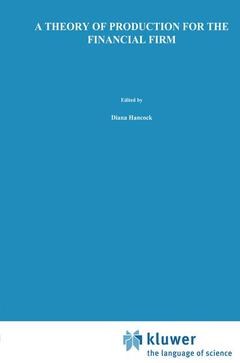A Theory of Production for the Financial Firm, Softcover reprint of the original 1st ed. 1991 Innovations in Financial Markets and Institutions Series, Vol. 4
Langue : Anglais
Auteur : Hancock Diana

Furthermore, if the effects of regulations on user costs are excluded, it is impossible to analyze monetary policy effects. Chapter 2 examines the principal areas of regulation that affect user costs. For example, reserve requirements, as administered by the Federal Reserve, act as a tax on financial firms so covered. Required reserves earn no return to the financial firm and there is foregone revenue. Deposit insurance increases the user cost of servicing deposits to the banks. Interest rate regulations place limits on interest rates on time de posits, or prohibit payments on demand deposits during part of the period studied. Underlying all these are the open market operations of the Federal Reserve, and their effects on interest rates and the quantities of financial goods. Chapter 2 reveals that previous work on the estimation of bank tech nologies is incomplete, and that the regulations require modelling as a part of the profit maximizing structure. 1.3 User Cost Derivation Chapter 3 discusses the construction of user costs. These are derived for the services from all assets or liabilities on a bank balance sheet or appearing on the income statement. The user cost formulation permits goods to be classified as outputs and inputs. Those with a positive user cost, where expenditures per unit exceed revenues per unit, are inputs. The unit for financial goods such as loans or deposits is one dollar per period. Goods with a negative user cost, with expenditures falling below revenue per unit, are outputs.
1 Introduction and Summary.- 1.1 The Need for a Theory of Production for Financial Firms.- 1.2 Issues in Technology and Regulation.- 1.3 User Cost Derivation.- 1.4 A Model of the Financial Firm.- 1.5 Data and Data Construction.- 1.6 Specification and Hypothesis Testing.- 1.7 Empirical Results.- 2 Issues in Technology and Regulation of Financial Firms.- 2.1 Introduction.- 2.2 Cost Function Approach.- 2.3 Profit Function Approach.- 2.4 Outputs, Inputs, and the “Classification Problem”.- 2.5 Regulations and the Financial Firm.- 2.6 Concluding Remarks.- 3 User Cost Derivation for Financial Firms.- 3.1 User Costs for Assets and Liabilities.- 3.2 Implementation Problems.- 4 A Model of the Financial Firm.- 4.1 Introduction.- 4.2 An Intertemporal Production Model of the Individual Financial Firm.- 5 Data and Data Construction.- 5.1 Introduction.- 5.2 Labor Services.- 5.3 Materials Services.- 5.4 Physical Capital Services.- 5.5 User Costs for Financial Services.- 5.6 Variable Profits.- 5.7 Concluding Remarks.- Appendix Functional Cost Data on Capital.- 6 Specification and Hypothesis Testing.- 6.1 Introduction.- 6.2 Profit Function and Net Supplies.- 6.3 Regularity Restrictions.- 6.4 Tests of Bank Technology.- 6.5 Econometric Issues.- 6.6 Concluding Remarks.- Appendix Derivation of Hessian - Variable Profit Function.- 7 Empirical Results.- 7.1 Introduction.- 7.2 Elasticities of Transformation, Demand and Supply.- 7.3 Regularity Tests.- 7.4 Estimation of Transformation, Supply and Demand Elasticities.- 7.5 Rate of Return on Capital.- 7.6 Policy Implications: Monetary Policy and Bank Behavior.- 7.7 Tests of Monetary Aggregation.- 7.8 Concluding Remarks.
Date de parution : 10-2012
Ouvrage de 157 p.
15.5x23.5 cm
Thèmes d’A Theory of Production for the Financial Firm :
Mots-clés :
© 2024 LAVOISIER S.A.S.



